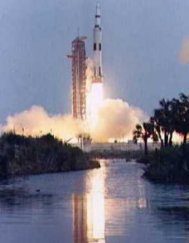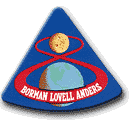

 At NASA the engineers were busy. While the new Apollo command and lunar modules were being designed, probes were being sent to the moon to determine potential landing sites. Meanwhile the first launch of the massive Saturn V rockets had proved successful. It had launched a payload of 280,000 pounds. This was more than the combined weight of all the previous probes and satelittes launched by the US.
At NASA the engineers were busy. While the new Apollo command and lunar modules were being designed, probes were being sent to the moon to determine potential landing sites. Meanwhile the first launch of the massive Saturn V rockets had proved successful. It had launched a payload of 280,000 pounds. This was more than the combined weight of all the previous probes and satelittes launched by the US.
Von Braun, the designer of the Saturn V rocket was ecstatic. At last he had created the interplanetary rocket he had dreamed of.
In October 1968 Apollo 7 lifted into orbit and the first American three man space flight was another tick in the right column.
 Apollo 8 was due to test the Apollo command and lunar modules in earth orbit but by September 1968 CIA had intelligence that a Russian spacecraft called Zond was being prepared to send a cosmonaut orbiting around the moon. Without actually landing a man on the moon the Russians could claim to have reached it first. NASA decided to change the Apollo 8 program and send the three astronauts on board to the moon... for Christmas.
Apollo 8 was due to test the Apollo command and lunar modules in earth orbit but by September 1968 CIA had intelligence that a Russian spacecraft called Zond was being prepared to send a cosmonaut orbiting around the moon. Without actually landing a man on the moon the Russians could claim to have reached it first. NASA decided to change the Apollo 8 program and send the three astronauts on board to the moon... for Christmas.
Once launched the crew of Apollo 8 were the first men to see the earth as a slowly shrinking globe as they blasted towards the moon. After travelling over half way to the moon they started to coast 'downhill'. This was the part of the journey where the pull of the moon's gravity was greater than the earth's.
To put Apollo 8 into lunar orbit the big retro booster on the spacecraft had to fire for 247 seconds. If it failed the Apollo 8 could slingshot around the moon and get a free ride home. If the booster failed half way through the burn then the spacecraft and its occupants would be sent out into deep space and certain death.
The booster would be fired when Apollo 8 moved behind the moon and out of radio contact with earth. It would only be when Apollo 8 reappeared from behind the moon that mission control would know whether they had achieved history or had just sent three men to their deaths.
Before the astronauts reached the moon's shadow they received the news they wanted to hear from mission control' "You are go all the way".
Jim Lovell, the pilot of the command module replied, We'll see you on the other side" and the spaceship plunged into radio silence.
As the minutes ticked by, mission control kept up the radio call "Apollo 8....Apollo 8....Apollo 8" until finally it was answered by Lovell's call "Go ahead Houston". Mission control went wild, Apollo 8 was in lunar orbit.
 It was Christmas eve and as the crew of Apollo 8 took it in turns to describe the surface of the moon, crew member Bill Anders closed his message with "and from the crew of Apollo 8 we close with good night, good luck, a Merry Christmas and god bless all of you - all of you on the good earth."
It was Christmas eve and as the crew of Apollo 8 took it in turns to describe the surface of the moon, crew member Bill Anders closed his message with "and from the crew of Apollo 8 we close with good night, good luck, a Merry Christmas and god bless all of you - all of you on the good earth."

 Page 7 |
 Page 9 |
